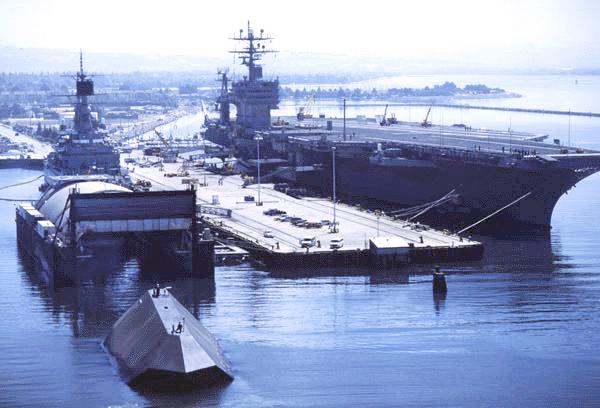Who remembers the stealth boat “Sea Shadow?” I do from when I was a kid but totally forgot about it until I read this. Sounds like these guys had an interesting time:
For decades, dozens of forgotten Navy and merchant ships have been corroding in Suisun Bay, 30 miles northeast of San Francisco. These historic vessels—the Mothball Fleet—served their country in four wars: WWII, the Korean War, the Vietnam War, and Desert Storm. After a decade of impasse, the ghost fleet is slowly dwindling as the ships are towed out one-by-one for scrapping. About 15 retired ships are already gone; by 2017, the entire fleet will be just a memory.
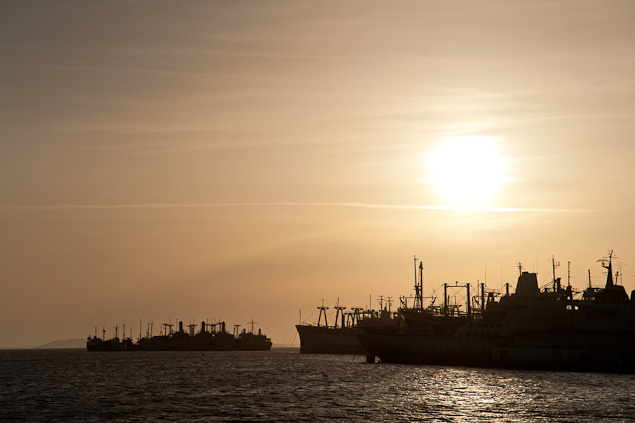 Over a two-year period, several close friends and I gained unprecedented access to the decaying ships, spending several days at a time photographing, documenting, and even sleeping aboard them—often in the luxury of the captain’s quarters. Sneaking on-board required months of planning and coordination, and it involved taking significant risks. Of course, things did not always go as planned, but despite several close calls, we were successful in all of our attempts to infiltrate the ships while evading round-the-clock security patrols.
Over a two-year period, several close friends and I gained unprecedented access to the decaying ships, spending several days at a time photographing, documenting, and even sleeping aboard them—often in the luxury of the captain’s quarters. Sneaking on-board required months of planning and coordination, and it involved taking significant risks. Of course, things did not always go as planned, but despite several close calls, we were successful in all of our attempts to infiltrate the ships while evading round-the-clock security patrols.
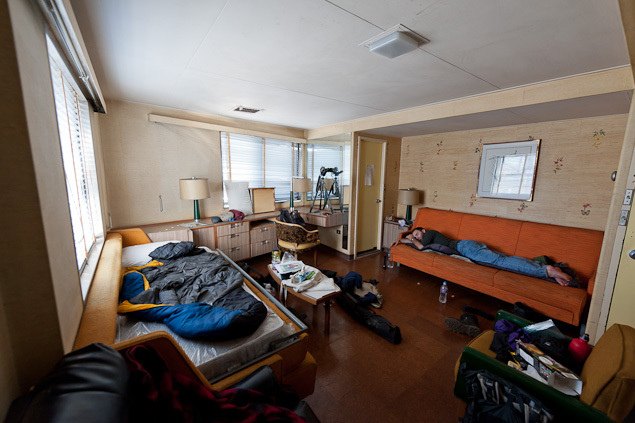 History and Current State
History and Current State
These ghost ships, part of the National Defense Reserve Fleet (NDRF) overseen by the U.S. Maritime Administration (MARAD), were supposed to be ready for duty in the event of a national emergency. Perhaps a few ships are actually “reserve ready” and could be activated, but the vast majority are well beyond their useful lives and rotting away as they wait in line for disposal.
The mothballed ships once numbered close to 400, and in 1959, 324 vessels still lined the waters of Suisun Bay. Although the ships continued to dwindle down over time, approximately 75 remained throughout the 2000s, rusting and leaching toxic heavy metals into the bay as the Bush administration did little to address the crumbling ships.
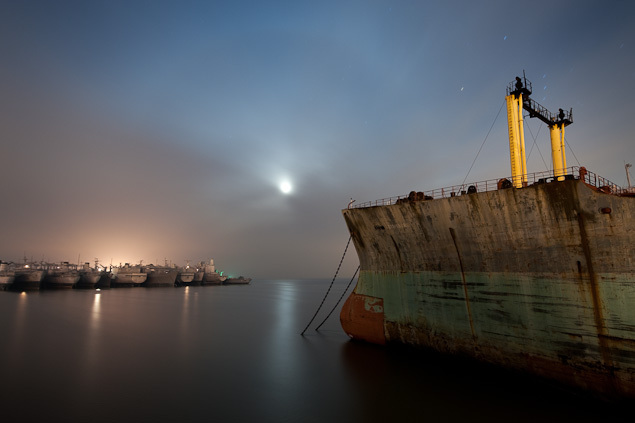 Many ships in the fleet served in World War II, including the historic USS Iowa, the last remaining U.S. lead battleship. Retired war ships like the Iowa were laid up in Suisun Bay for decades awaiting their next battle, but the call never came. Instead, they have sat unused and largely forgotten. But the Iowa will likely see a different fate than its sister ships who await their ultimate demise at a shipbreaker. Vallejo is currently in a heated battle with the port of Los Angeles (San Pedro) to secure rights to the battleship and turn it into a museum.
Many ships in the fleet served in World War II, including the historic USS Iowa, the last remaining U.S. lead battleship. Retired war ships like the Iowa were laid up in Suisun Bay for decades awaiting their next battle, but the call never came. Instead, they have sat unused and largely forgotten. But the Iowa will likely see a different fate than its sister ships who await their ultimate demise at a shipbreaker. Vallejo is currently in a heated battle with the port of Los Angeles (San Pedro) to secure rights to the battleship and turn it into a museum.
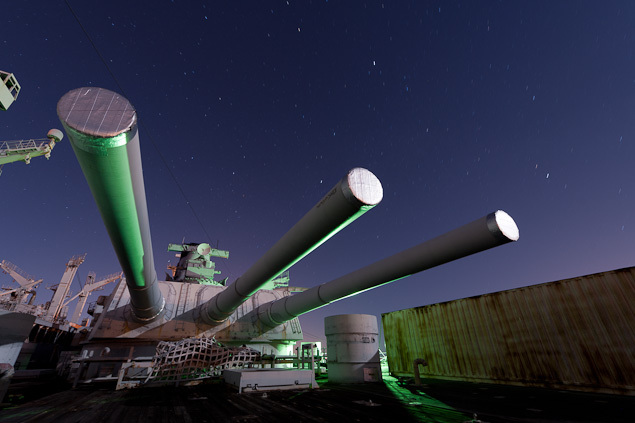 Guns on the deck of the USS Iowa.
Guns on the deck of the USS Iowa.
Ticking Environmental Time Bombs
The ships have shed more than 20 tons of toxic paint debris that have settled into bay sediments, where they will cause problems long after the ships are gone. Even though Congress and the State of California ordered MARAD to address the situation, nothing was done for most of the past decade. Lawsuits filed by environmental groups were also unsuccessful in forcing MARAD to remove the ships. However, after Barack Obama took the Oval Office in 2008, the tide shifted and MARAD began working diligently to clean up and remove the ships.
Planning
As news began to mount that the ships would finally be towed out for scrapping, we knew we had to act fast if we wanted to explore and document them. We had fantasized for years about getting aboard, but it always seemed too difficult and other sites presented fewer challenges. In addition, the potential repercussions of trespassing are likely more severe than other locations we explore. One intimidating factor was our inability to find out what the penalties might entail if we did get caught, making it difficult to weigh the risks.
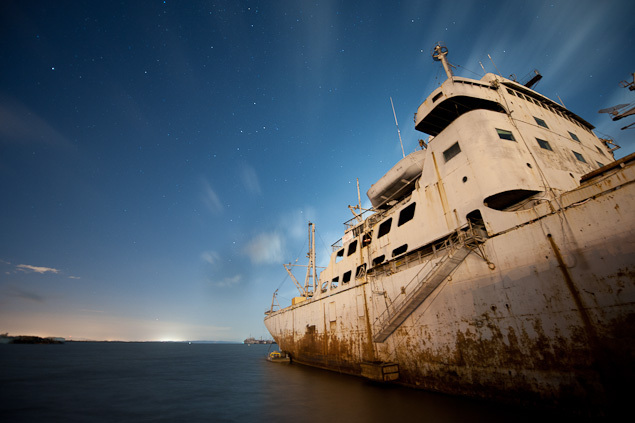 The President, which was towed to Mare Island in March 2011 to be scrapped. In May, it was towed out again, this time to Texas, in a swap for its sister ship, the President Lincoln, which was deemed too un-seaworthy to make the voyage to Texas.
The President, which was towed to Mare Island in March 2011 to be scrapped. In May, it was towed out again, this time to Texas, in a swap for its sister ship, the President Lincoln, which was deemed too un-seaworthy to make the voyage to Texas.
But we knew that many inherent risks could be mitigated with enough planning and preparation. Before making our first trip on the water, Stephen scoped out the environs to assess how close we could get to the water on foot, which along with satellite imagery, helped us determine our route. Later, we made a second visit just to observe the 24-hour security patrols from the safety of the shoreline. We also purchased a scanner to eavesdrop on nearby radio communications and studied tidal patterns, planning our trips accordingly.
We had to overcome numerous obstacles just to get to the ships without even addressing the issues involved in getting on them. To get across the channel, we acquired a small, inflatable raft that was just big enough for the three of us and our gear, along with a small motor powered by a car battery. A raft seemed ideal several reasons: 1. it was not possible to drive up to the drop-in point, so we needed something lightweight to carry across the marsh, along with our camera gear, food, water, and sleeping bags; 2. we needed a boat that we could maneuver through extremely shallow tidal flats near the shore; 3. The raft’s low profile and nearly silent motor would help us evade security patrols; 4. a raft would be the easiest type of vessel to pull aboard the ships once we found a way on, and we could then deflate it and stash it away from prying eyes.
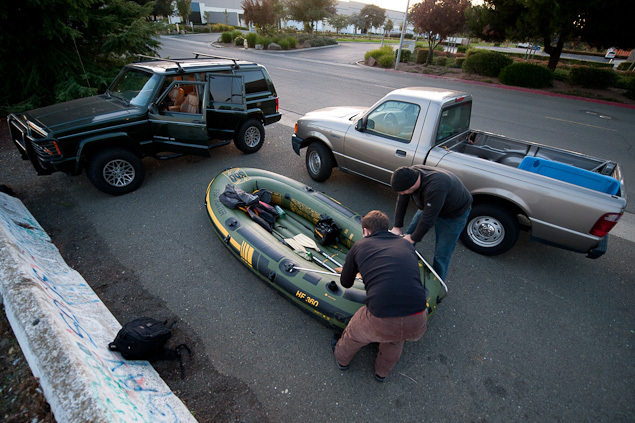 An inflatable raft does have its disadvantages. For one thing, it’s only possible to mount a tiny, low power motor on an inflatable raft. But the primary drawback is that holes are nearly inevitable. On our second trip, we discovered several holes as we readied the boat along the roadside. Luckily, we found a patch kit at a nearby gas station, and we were back in business. Another time, we discovered leaks on our return trip as we were leaving the ships. In this case, we continuously pumped up the boat while still on the water.
An inflatable raft does have its disadvantages. For one thing, it’s only possible to mount a tiny, low power motor on an inflatable raft. But the primary drawback is that holes are nearly inevitable. On our second trip, we discovered several holes as we readied the boat along the roadside. Luckily, we found a patch kit at a nearby gas station, and we were back in business. Another time, we discovered leaks on our return trip as we were leaving the ships. In this case, we continuously pumped up the boat while still on the water.
Scouting Mission
For our first trip, we decided to play it safe and treat it purely as a scouting mission. We did not bring our cameras or overnight gear, and we approached the ships cautiously. Warning signs posted on the hulls instruct you to stay at least 500 feet away. When we agreed it was safe, we breached the 500 foot barrier, and found a place with good cover where we could scope out potential ways aboard. To our surprise and delight, it was easier to climb aboard than we had imagined. It was a huge rush to climb aboard for the first time, but we did not stay long in case we set off alarm sensors. We turned back and called it a weekend, but now we knew it was possible.
Aboard the Ships
On subsequent trips, we spent the entire weekend aboard the ships, each time on a different row. Because they are tethered closely together in rows, we had many ships to explore—enough to keep us occupied for a week or more if the excursions were not so draining and we did not have jobs pulling us back. But the main reason we stayed all weekend is simply because it was such a challenge to get out there. Getting aboard was both physically and emotionally draining and was the riskiest part of the endeavor.
 Once aboard, everything seemed to slow down. The adrenaline rush and anxiety I felt as we approached the ships instantly faded once we climbed aboard safely. I found it easy to relax and enjoy the quiet and stillness of the evening, miles from the hustle and bustle of modern civilization. We heard nearby trains rumbling as they passed, even inside the ships, but that’s it. Otherwise, it was just us and a few birds of prey that call the ships home.
Once aboard, everything seemed to slow down. The adrenaline rush and anxiety I felt as we approached the ships instantly faded once we climbed aboard safely. I found it easy to relax and enjoy the quiet and stillness of the evening, miles from the hustle and bustle of modern civilization. We heard nearby trains rumbling as they passed, even inside the ships, but that’s it. Otherwise, it was just us and a few birds of prey that call the ships home.
Getting inside the ships was usually not straightforward, and sometimes impossible. MARAD locks them down tight, but there are so many possible entrances that persistence often paid off. One of the first orders of business each trip was finding a place to sleep. The ships are often stinky from mold, mildew, PCBs, and decay, so a room with windows that opened was preferable. We typically slept in the captain’s room where we found comfy couches, convertible beds, lots of space, and plenty of light during the daytime.
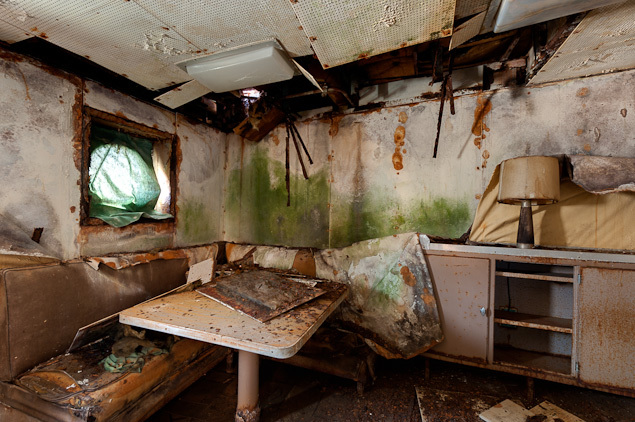 We slept during the day after shooting and exploring all night. Around noon, we would wake up and eat and explore the bowels of the ships. We had to be careful moving around on the decks during the day, but because the ships are so tall, it was still fairly low-key—at least during our initial trips. On later trips, we ran into crews working on the ships, even on weekends, due to increased cleanup efforts. Luckily we always saw or heard them before they saw us!
We slept during the day after shooting and exploring all night. Around noon, we would wake up and eat and explore the bowels of the ships. We had to be careful moving around on the decks during the day, but because the ships are so tall, it was still fairly low-key—at least during our initial trips. On later trips, we ran into crews working on the ships, even on weekends, due to increased cleanup efforts. Luckily we always saw or heard them before they saw us!
Final Trip
On our final trip, we visited the “J Row,” the closest row to security headquarters where 24-hour crews keep a watchful eye on the ships. It would prove to be our most harrowing trip yet, because we had to pass within a couple hundred feet of the converted boathouse where the guards reside.
As we boarded the ships, a patrol boat zoomed up on us and started shining spotlights. Luckily, we had already climbed to safety, but it seemed odd that they accosted us like that. Fearing that we might have tripped alarm sensors, I had an uneasy feeling all weekend as we explored the ships. Despite ramped up patrols and uncharacteristic spotlighting all night long, we spent the weekend exploring the ships unscathed.
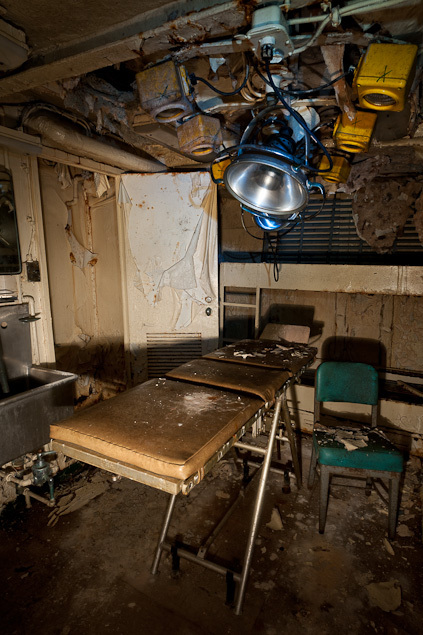 However, as we prepared to leave, we got buzzed by security again while inflating our raft on a barge near water level. With nowhere to hide, we literally hit the deck and prayed that they would not see us. In the scramble, Stephen dropped both paddles through a thin slot on the barge. Not only were we now lacking an essential piece of equipment that we needed to get back to shore, but worse, the paddles might float out in view of the security boat. All three of us began to panic, but there was little we could do. After a couple false starts when it initially appeared security had moved on, we frantically dropped our boat in the water, followed by our gear and ourselves, trying to be careful not to dunk our expensive cameras in the frenzy.
However, as we prepared to leave, we got buzzed by security again while inflating our raft on a barge near water level. With nowhere to hide, we literally hit the deck and prayed that they would not see us. In the scramble, Stephen dropped both paddles through a thin slot on the barge. Not only were we now lacking an essential piece of equipment that we needed to get back to shore, but worse, the paddles might float out in view of the security boat. All three of us began to panic, but there was little we could do. After a couple false starts when it initially appeared security had moved on, we frantically dropped our boat in the water, followed by our gear and ourselves, trying to be careful not to dunk our expensive cameras in the frenzy.
Remarkably, we found one of the oars floating out from under the barge right where we dropped the raft in the water. The other was about 50 feet away in a relatively calm patch of water next to the President, the last ship in the row. We decided to detour to retrieve the paddle, which would burn a couple minutes and leave us vulnerable if the security boat returned. Fortunately it did not, and we got away from the ships quickly, thanks to gallant rowing efforts by Jon and me as Stephen motored ahead.
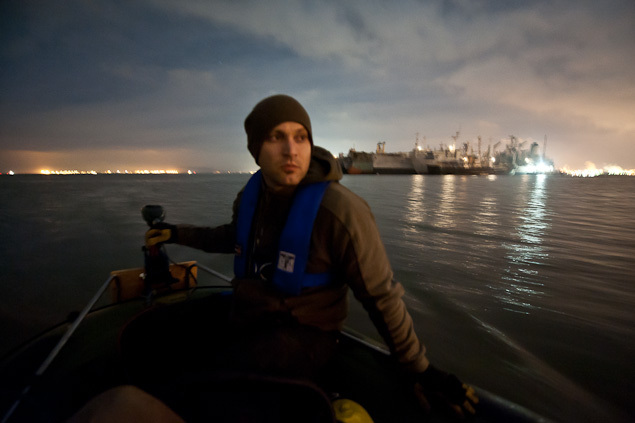 But before we could get outside the invisible 500 foot barrier, we found ourselves right in the beam of the security boat’s search light. We were had! We stopped paddling, and desperately tried to come up with a good cover story. Practically admitting defeat, we decided that there was not much we could say, and we feared our gear would give us away. Then, astonishingly, after being in direct view of the boat’s spotlight for at least 10 seconds, the light moved off us and nothing happened. We kept rowing. The light came back a second time, further escalating our sense of despair. But then, the light went off of us again! We could not believe it—the boat turned and went the other way, but we still were not certain we were off the hook.
But before we could get outside the invisible 500 foot barrier, we found ourselves right in the beam of the security boat’s search light. We were had! We stopped paddling, and desperately tried to come up with a good cover story. Practically admitting defeat, we decided that there was not much we could say, and we feared our gear would give us away. Then, astonishingly, after being in direct view of the boat’s spotlight for at least 10 seconds, the light moved off us and nothing happened. We kept rowing. The light came back a second time, further escalating our sense of despair. But then, the light went off of us again! We could not believe it—the boat turned and went the other way, but we still were not certain we were off the hook.
We frantically rowed until we reached the shore, fearing at any moment they would come for us. It was not until we reached the safety of the small marshy channel that we breathed a huge sigh of relief. The sun was about to rise and the morning chorus of chirping birds began. We were exhausted and vowed that this trip, our fifth, would be our last visit. Sadly, it was.
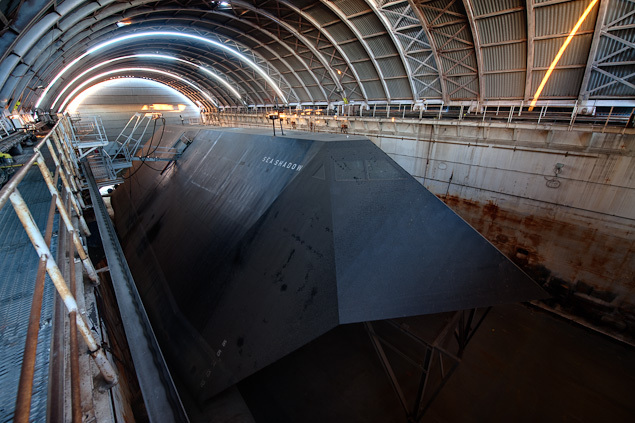
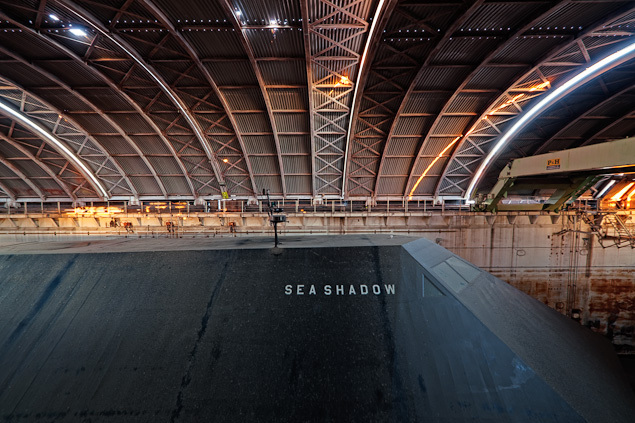
The Sea Shadow was locked up tight. Otherwise we would have been right in there, first thing – trust me! It may look wide open, but the door was actually locked (albeit with a cheap Masterlock).
More pics at the bottom of the page: http://scotthaefner.com/beyond/mothball-fleet-ghost-ships/
